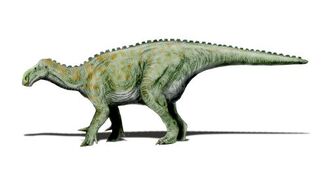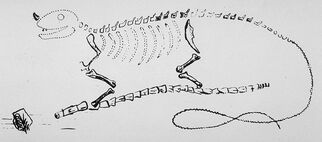
Modern restoration of Iguanodon
Iguanodon was an ornithopod dinosaur of Early Cretaceous Europe.
Description[]
Normally, Iguanodon measured about 10 meters long (with some exceptional specimens reaching 13 meters long[1]) and weighed about 3.5 tons. As its name suggests, Iguanodon had teeth rather like those of the modern iguana.
The limbs of Iguanodon were long and well-built, and could support the animal's weight in both bipedal and quadrupedal stances. The thumbs of the front hands were tipped with large spikes, fossils of which caused confusion after their initial discovery.
Classification[]
Iguanodon was an ornithopod dinosaur and gave its name to the clade Iguanodontia, which contains the hadrosaurs among other animals. Iguanodontidae was originally its own family.[2]
Species[]
Iguanodon anglicus was the original type species described by Gideon Mantell (in genus only; the species name was added in 1829 by Friedrich Holl[3]), but as it was only based on fragmentary remains, the International Commission on Zoological Nomenclature in 2000 transferred the type species to I. bernissartensis, which is much more completely known. Currently, I. bernissartensis is one of three Iguanodon species recognized, and the only one accepted by a majority of the scientific community. In the past, there have been dozens of reptile species listed as Iguanodon at various times.
History[]
Gideon Mantell began to find bones of a large animal in a quarry at Whitemans Green, Sussex, England, around 1820. He believed the bones were from a giant reptile, and after finding teeth from the animal in 1822 he started showing them to other scientists, who dismissed them as being from a rhinoceros. In 1824, Georges Cuvier examined the teeth and found that they were indeed from some sort of giant herbivorous reptile, leading Mantell to compare the fossils to teeth of extant reptiles.[4]
Sameul Stuchbury of the Royal College of Surgeons noticed that the teeth resembled those of a modern iguana he had recently examined, although much larger.[5] Based on this, Mantell proposed naming the creature "Iguanasaurus" (iguana lizard), but the geologist William Daniel Conybeare stated that the name was equally applicable to the modern iguana itself and suggested the names Iguanoides (iguana-like) or Iguanodon as alternatives. Mantell decided to name his creature Iguanodon and described it in 1825, estimating the animal's length at about 18 meters long.[6]

Mantell's tentative Iguanodon restoration in 1834
In 1834, an incomplete specimen was found in Maidstone, Kent, which allowed for the first artistic reconstructions of Iguanodon. They depicted the dinosaur as quadrupedal and lizard-like. Mantell identified the skeleton from its teeth, but mistakenly put the animal's thumb spike on its nose, believing it to be a horn.[7] The Maidstone specimen is still on display in London.
The most complete specimens of Iguanodon were found in 1878 at the Bernissart coal mine in Belgium. At least 38 individuals, most of them adults, were found as mostly complete skeletons.[8] In storage, however, many bones succumbed to "pyrite disease" (where pyrite accumulated in the mineralized bones starts to oxidize and deteriorate the bone), which necessitated extensive restoration techniques in order to keep them intact.[9] These new specimens allowed paleontologists to conclude that the animal may have been bipedal instead of quadrupedal, and that the nose horn was instead a thumb spike.[10]
In later years, the posture of Iguanodon was again changed, and numerous species in the genus were reclassified and moved to different genera.[11] In 2003, organic proteins were found preserved in a rib bone from Iguanodon.[12]
Paleobiology[]
Diet[]
Iguanodon was a herbivore, and may have eaten cycads, conifers, and angiosperms.[13]
Posture[]
Originally, Iguanodon was depicted as being quadrupedal. During the 1870s when complete specimens were found in Belgium, it was discovered that a bipedal posture was more likely. As a result, Iguanodon was illustrated and mounted in museums rather like a kangaroo, with its tail acting as a "tripod" to support the rest of the body. Modern interpretations show that Iguanodon was likely both: it was normally a quadrupedal walker, but could raise up on its hind legs while running or feeding on high vegetation.[14]
In popular culture[]
Ever since its reconstruction at Crystal Palace Park, Iguanodon has been a familiar dinosaur.[15] It has appeared in several different books, movies, and television shows. The asteroid 9941 Iguanodon was named after the genus.[16]
References[]
- ↑ Naish, Darren; David M. Martill (2001). "Ornithopod dinosaurs". Dinosaurs of the Isle of Wight. London: The Palaeontological Association. pp. 60–132. ISBN 0-901702-72-2.
- ↑ Galton, Peter M. (September 1974). "Notes on Thescelosaurus, a conservative ornithopod dinosaur from the Upper Cretaceous of North America, with comments on ornithopod classification". Journal of Paleontology 48 (5): 1048–1067. ISSN 0022-3360. JSTOR 1303302.
- ↑ Holl, Friedrich (1829). Handbuch der Petrifaktenkunde, Vol. I. Ouedlinberg. Dresden: P.G. Hilscher. OCLC 7188887.
- ↑ Cadbury, D. (2000). The Dinosaur Hunters. Fourth Estate:London, 384 p. ISBN 1-85702-959-3.
- ↑ Glut, Donald F. (1997). "Iguanodon". Dinosaurs: The Encyclopedia. Jefferson, North Carolina: McFarland & Co. pp. 490–500. ISBN 0-89950-917-7.
- ↑ Mantell, Gideon A. (1825). "Notice on the Iguanodon, a newly discovered fossil reptile, from the sandstone of Tilgate forest, in Sussex". Philosophical Transactions of the Royal Society 115: 179–186. doi:10.1098/rstl.1825.0010. ISSN 0261-0523. JSTOR 107739.
- ↑ Mantell, Gideon A. (1834). "Discovery of the bones of the Iguanodon in a quarry of Kentish Rag (a limestone belonging to the Lower Greensand Formation) near Maidstone, Kent". Edinburgh New Philosophical Journal 17: 200–201.
- ↑ van Beneden, P.J. (1878). "Sur la découverte de reptiles fossiles gigantesques dans le charbonnage de Bernissart, près de Pruwelz". Bulletin de l'Institut Royal d'Histoire Naturelle de Belgique 3 (1): 1–19.
- ↑ Norman, David B. (1985). "To Study a Dinosaur". The Illustrated Encyclopedia of Dinosaurs: An Original and Compelling Insight into Life in the Dinosaur Kingdom. New York: Crescent Books. pp. 24–33. ISBN 0-517-46890-5.
- ↑ Dollo, Louis (1883). "Note sur les restes de dinosauriens recontrés dans le Crétacé Supérieur de la Belgique". Bulletin du Musée Royal d'Histoire Naturelle de Belgique 2: 205–221
- ↑ Paul, Gregory S. (2008). "A revised taxonomy of the iguanodont dinosaur genera and species". Cretaceous Research 29 (2): 192–216. doi:10.1016/j.cretres.2007.04.009.
- ↑ Embery, Graham; Milner, Angela C.; Waddington, Rachel J.; Hall, Rachel C.; Langley, Martin S.; and Milan, Anna M. (2003). "Identification of proteinaceous material in the bone of the dinosaur Iguanodon". Connective Tissue Research 44 (Suppl. 1): 41–46. doi:10.1080/713713598. PMID 12952172.
- ↑ Bakker, R.T. "When Dinosaurs Invented Flowers". The Dinosaur Heresies, 179–198
- ↑ Norman, David B. (2004). "Basal Iguanodontia". In Weishampel, D.B., Dodson, P., and Osmólska, H. (eds.). The Dinosauria (2nd ed.). Berkeley: University of California Press. pp. 413–437. ISBN 0-520-24209-2.
- ↑ Smith, Dan (2001-02-26). "A site for saur eyes". New Statesman. Retrieved 2007-02-22.
- ↑ "JPL Small-Body Database Browser: 9941 Iguanodon (1989 CB3)". NASA. Retrieved 2007-02-10.